



![]()
| Hello Children,
In a few days time we'll be celebrating our 50th anniversay of Independence, an important event in Sri Lankan history. Did you know that when Sri Lanka then known as Ceylon gained independence and raised the flag it was quite different from the present flag? The Lion flag was modified in 1951 and the orange and green stripes were added to represent the Hindu and Buddhist minorities. Celebrating our Independence on a grand scale is good but we shouldn't forget that to honour this great occasion we must live together in harmony accepting Sinhalese, Tamils, Muslims and Burghers alike as our brothers and sisters. Until next week, Aunty Sunshine |
When the sessions of sweet
Silent rememberance,
A thousand tender pleasures,
Yours and mine.
Still remain like glorious water,
The Opal's flower is to the opal sweet.
Though to itself only live and due
But if that flower with a
Friend like you will shine bright
And enlighten the whole universe
While I think of you, dear friend,
All losses are restored and sorrows
Will end in delight
Farewell English Rose,
Lady Diana of Britain
Princess of many
Now lies in deep sleep
To the sick and the needy,
She was there to comfort and hold,
And share with them their woes;
Sacrificing her precious time
for a worthy cause,
We will all miss you dearly,
May you find enternal peace.
Dodi and Lady Diana
Started to fall in love,
And as their love started to blossom
into something beautiful,
Alas! when she did begin to find,
Real happiness with him,
Out of the blue like a Thunder Bolt
And a Flash of Lightning
Came the cruel blow,
In the Black Tunnel in Paris
A fatal accident
Dodi was gone forever and the chauffear too;
They took Diana so fair and frail,
From the twisted Metal wreck,
Wounded all over, and fighting for her life,
After a medical battle,
Her life was snatched away,
Lady Diana so full of life,
Snuffed out, forever from us all,
Into the Arms of God,
And there may you find,
Peace and Happiness
That you have been deprived of,
In the troubled life you led,
Within the Palace walls,
Of your short life - span,
In the next birth may you be born,
In a better place than this,
A place fit for a Queen of Hearts,
A home with lots of Love and Peace
William Shakespeare was born in Stratford on Avon 1564.
He was a most famous writer of plays in the English language. Shakespeare married Anne Hathaway in 1582 and they had three children.
Their names were Suzanna, Hannet and Judith. William Shakespeare died in Stratford on 23 April 1616. Even today we study his works.
Stamp News 3 STAMP CORNER |
Ancient kings of Sri Lanka celebrated their assumption
to kingship with an Abhishekha ceremony. It was also known as Moulimangalla,
the feast of consecration. Ancient chronicles describe this ceremony in
detail. Among the royal ornaments 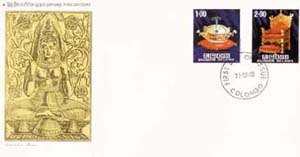 required
for the consecration were three important elements - the white parasol,
the crown and the throne. The ceremony took place in a special assembly
hall prepared for the occasion.
required
for the consecration were three important elements - the white parasol,
the crown and the throne. The ceremony took place in a special assembly
hall prepared for the occasion.
The throne of the king was frequently described as a lion seat (simhasana) since the lion was considered the symbol of royal power. There have been instances when the king's throne was in the form of a crouching lion.
Whenever the king sat on the throne, he always wore a crown set with precious jewels.
Although many items of ancient regalia are mentioned in early Sinhala literature, the only items which we possess today are those of the last kings of the Kandyan kingdom. The crown and the throne of the King of Kandy have become symbols of our rich heritage.
The eight cornered, gold crown (seen in Re. 1 stamp) is referred to as 'Ata-mulu Toppiya'. Records show it has been first worn by King Sri Vijaya Rajasinghe (1739-47) followed by his successors Kirti Sri Rajasinghe (1747-82), Rajadhi Rajasinghe (1782-98) and Sri Vikrama Rajasinghe (1798-1815).
The dome of the crown is of gold sheeting with elaborate floral ornament.
It is studded with rubies, emeralds and sapphires. At 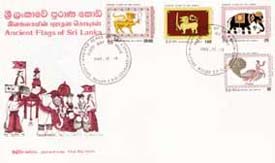 the
centre is the Mal Gaha or Royal tree of flowers with the leaves appearing
to be stylized Bo leaves.
the
centre is the Mal Gaha or Royal tree of flowers with the leaves appearing
to be stylized Bo leaves.
The throne and foot stool (Rs. 2 stamp) were a gift to King Vimala Dharma Suriya II (1687-1717) by the Dutch Governor of Ceylon, Thomas van Rhee in 1693. (The Dutch were occupying the maritime provinces since 1656). In its design the throne resembles royal chairs used in France and in its basic style, Baroque of King Louis XIV (1690-1700). It is distinctly eastern in its carvings and decoration with the frame made of jak wood and covered entirely with gold sheeting. It is set with amethysts and cut crystal. The two arms carry two figures of lions suggesting the lion symbol of the Sinhala race. The inside of the back of the throne is filled with acanthus foliage ornament with the sun in the middle and two seated female figures on either side.
The crown and the throne which were taken to England following the capture of Kandy by the British and kept in Buckingham Palace were returned in 1934. On 20 September that year the Duke of Gloucester brought them on his way to Japan. They are now preserved in the National Museum in Colombo.
The two stamps designed by R. B. Mawilmada were issued on 18 January 1977.
Ancient Flags
Befitting her magnificent cultural heritage Sri Lanka has also displayed diversity and richness in her flags, banners and standards. A flag or a banner is the vehicle for a nation's pride and its aspirations. These have been used as rallying points in battle but more often in royal or religious processions. Apart from the royal flag, there were flags for different provinces, districts, princess and chieftains.
Four stamps depicting ancient flags were issued on 18 December 1980 to coincide with an exhibition of 'Historic Flags and Banners of Sri Lanka' organized by Mrs. J. L. M. Fernando who has also been credited with the designing of the stamps.
Two stamps had the lion flag. Rs. 1.60 stamp has the last King of Kandy, Sri Vickrema Rajasinghe's civil standard. Known as the Sinhala Rajakiya Dhajaya, it was the flag which was hoisted to mark the gaining of Independence in 1948. The flag carries a passant royal lion carrying a sword in its right fore-paw within a plain border with four bo-pat (bo leaves) from each corner.
The Rs. 20 stamp is the Sinhala Royal Flag, Ratnapura. It depicts a passant royal lion holding a whip in its raised fore-paw. The whip is the whip of authority which is cracked before the Sovereign and the Adigar in processions.
The 25 cent stamp is the Hastiya Maha Kodiya or the Elephant Banner - the flag carried by the Gajanayake Nilame, an officer of the palace who was in charge of the royal elephants. The fully caparisoned elephant holds a flower at the tip of its trunk. Flags carrying the image of an elephant were regarded as fortunate and auspicious.
The 10 cent stamp is the Mayura Maha Kodiya or the Peacock Banner, the emblem of Walapane Disawa. The peacock in all its splendour holding a snake in its beak is depicted.
It was so funny to see this giant pachyderm, virtually rolling around in the mud like a piglet!'.
An elephant in the throes of death? Thankfully No! He's just taking a good scratch!
Yes, this unusual sequence of photographs were taken by me in the Uda Walawe National park recently.
It had been raining very heavily and for the first time in three years
the sluice gates of the Walawe reservoir had been opened. 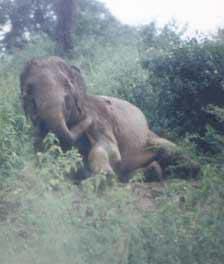 The
sight of the white 'frothy' water roaring downstream at some 2000 cubic
meters per second was spectacular.
The
sight of the white 'frothy' water roaring downstream at some 2000 cubic
meters per second was spectacular.
The roads within the park were muddy and most of the 'aras' were impassable, swollen with rushing water. The bungalow within the park where we were staying this time, Thimbiriyamankada, had been 2 feet under water the previous day.
We were driving along the main road on a very gloomy evening and game was sparse because of the heavy rain. Suddenly we came across this young male elephant. He was about 7-8 feet tall and perhaps around 20 years old. In customary fashion I killed the engine of the land cruiser immediately, and I don't think he really saw us.
He casually ambled on to a mould of earth by the side of the road, (which was a veritable mud heap due to the rains) climbed on to it, and surveyed the surroundings. We were astonished when he next lowered himself on his hind legs and virtually sat on the mud heap and rubbed his backside, with a blissul look on his face. We couldn't believe our eyes when he then decided to rub mud on to his body, and lay down completely on his side. At one point his torso almost slid off the mud heap and he balanced himself by raising his hind legs in the air.
It was so funny to see this giant pachyderm, virtually rolling around in the mud like a piglet!'. Having thoroughly satisfied himself; he then lumbered on to his feet and calmly walked back into the jungle.
A truly memorable and unique experience !!!!.
Our sun seems big and important to us. But really
it is no different from all the stars that we see as tiny points of lights
in the night sky. The stars seem so small because they are so far away
but some are actually much bigger than our sun. Some are 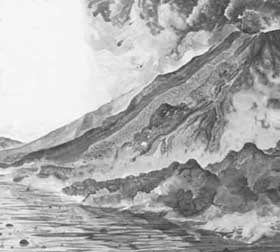 older,
and some are younger. By studying the stars scientists can guess how our
sun, and the planets that circle round it, were formed.
older,
and some are younger. By studying the stars scientists can guess how our
sun, and the planets that circle round it, were formed.
Formation stars
They all probably formed about 4,600 million years ago, and started as an enormous spinning cloud of gas. Gradually, the gases at the centre of the cloud condensed together to form the planets. The outer planets, which are far from the light and warmth of the sun. are cold masses of gas and ice. The inner planets lying closer to the sun are very hot. The earth, too, was very hot when it first formed. It began as a mass of glowing gas which gradully cooled and turned to liquid. Then a solid crust of rock formed on its surface. Even today, the inside of the earth is still hot, and when volcanoes erupt they throw out molten rock which we call lava.
The atmosphere of the earth at first contained gases such as hydrogen,
carbon dioxide, methane and ammonia. Water, too, 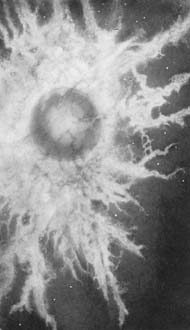 was
only a steamy vapour in the air. It took millions of years for the first
rain to form. Only then could streams and rivers appear. The seas and oceans
formed when pools of water gradually ran together.
was
only a steamy vapour in the air. It took millions of years for the first
rain to form. Only then could streams and rivers appear. The seas and oceans
formed when pools of water gradually ran together.
The Beginning of life
Many types of chemical were dissolved in these warm waters. When lightning from storms struck into the water, electrical energy linked the chemicals together in many different ways. Eventually, a chemical appeared that could make more molecules like itself. That was the beginning of life. Scientists believe that this first form of life appeared about 3,000 million years ago.
The first living things
The earliest types of life must have been quite tiny and simple, like bacteria. They probably got their energy from breaking down other complex chemicals around them. Some of these early living things evolved a green chemical that absorbed the energy from the sunlight in order to make their own food. These were the first plants, and must have been like microscopic single-celled algae. Animals cannot make food. They get their energy from eating plants or eating other animals. So they could only evolve after the first plants, perhaps 1,000 million years ago. These first animals were tiny single-celled organisms too.
Every living organism must be able to do two things. It must be able to use energy to make more of its own body chemicals so that it can grow. And it must be able to reproduce, making more organisms, each like itself.
Evolution
Each pair of animals or plants can produce very many offspring, but in each generation most of the offspring die before they grow up. That is why scientists speak of a "Struggle for survival". Though each organism is very like its parents, no two organisms are quite identical. Perhaps one plant may be able to grow a little faster, or one animal may be able to run a bit further than its brothers and sisters. Any animal or plant with such an advantage is more likely to be able to survive to grow up and produce its own offspring. In this way, by the "natural selection" of those with advantages, animals and plants gradually change or " evolve" over many generations.
Return to Mirror Magazine contents
![]()
Please send your comments and suggestions on this web site to
info@suntimes.is.lk or to
webmaster@infolabs.is.lk